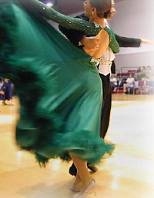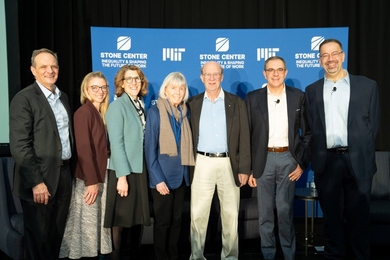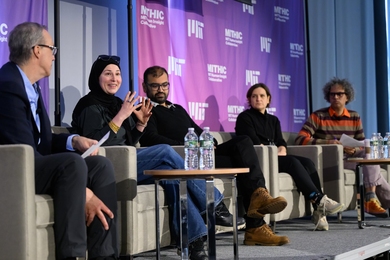Samba scrimmages? Tango tournaments? Rumba rumbles? Hundreds of twinkle-toed competitors, mostly college students from throughout the northeast will converge on MIT's du Pont Athletic Center for the MIT Open Ballroom Dance Competition on April 5-6.
Established at MIT in 1997, the event features six levels of competition from newcomer to championship in four styles of dance: standard (waltz, tango, Viennese waltz, foxtrot and quickstep), Latin (cha-cha, samba, rumba, paso doble and jive), smooth (waltz, tango, foxtrot and Viennese waltz) and rhythm (cha-cha, rumba, swing, bolero and mambo). Awards include $1,000 in scholarships.
At last year's competition, which drew nearly 600 dancers from 38 schools, the MIT team of graduate students Igor Pavlovsky (mathematics) and Yanfeng Lin (biology) won the championship-level Open Standard. This year the duo will defend that crown.
Their glides and dips may look effortless, but most teams devote countless hours to practicing the art. Genevieve Cuevas and Carlos Lopez, both seniors in electrical engineering and computer science who dance in the international-style Latin events, practice about three hours each day, six days a week. Their main coach is in Boston, where they take two hours of lessons each week, but they also travel to New York twice a month for lessons.
Mathematics senior Tilke Judd, who will compete in the gold and pre-championship Latin and rhythm events with two different partners, began ballroom dancing as a freshman at MIT. "I like to say that I came to MIT because they had the best ballroom dance team," she said, noting that she did what she calls her "whole rookie-yearling-veteran dancer sequence" at MIT.
Although most couples have set choreographies, it's inevitable, says Cuevas, that couples crash into each other now and then, especially at the lower levels where "they just pack the dance floor with competitors."
The art of preventing these crashes is known as "floor craft." With experience, says Judd, the dancers learn tactics for getting around the floor effectively.
The grace and precision of the competing dancers is not the only spectacle on view, notes Lin, who says the fashion show is also of interest. "There are lots of fancy gowns, many with feathers, floats, multiple layers and rhinestones," she said. Female dancers may also have neck and arm bands and elaborate headwear, while the men can be seen in tail suits and black costumes for Latin dance." Dancers who perform more than one style bring multiple costumes.
"I'm getting all my fake eyelashes and nails in order," laughs Judd who has a short Latin costume and a long ballgown for her two events.
Guest performers
In addition to the competition, the South African duo Michael Wentink and Beata--undefeated world amateur Latin champions as well as world professional Latin grand finalists--will present a special performance on Sunday, April 6 at approximately 4:30 p.m. (the time will depend on the number of contestants and the duration of the preceding competition). Lin, who evokes physics analogies although she's studying biology, calls the duo "hotter than plasma and cooler than supercool atoms."
Competitions are scheduled from 9 a.m. to 8 p.m. on April 5-6. The grand finals will take place at the end of each individual competition session on Sunday, April 6. Lin suggests that the best times for watching fancy footwork will be around 4 p.m. for standard and smooth (pre-championship and championship) and 7 p.m. for Latin and rhythm.
For more information, see http://mitbdt.mit.edu/comp.
A version of this article appeared in MIT Tech Talk on April 2, 2003.






